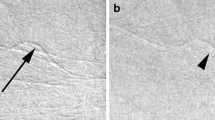Abstract
In contrast-enhanced DBT (CE-DBT), breast lesion vascularity is characterized by administrating an iodinated vascular contrast agent. In this work, a combined temporal and dual-energy (DE) subtraction CE-DBT technique was performed in 4 women with mammographic findings that warranted biopsy. Lesion enhancement characteristics and morphology obtained with both CE-DBT techniques are correlated to lesion enhancement characteristics and morphology obtained with CE-MRI. The findings are compared to the clinical outcome of the regular DBT exam. Preliminary results show that both temporal and DE CE-DBT provide morphologic and qualitative vascular information concordant with CE-MRI. Temporal subtraction is the most sensitive method since background breast tissue can be completely canceled while with DE CE-DBT tissue background can only be partially canceled. However, the temporal CE-DBT image data suffer from significantly more motion artifacts and therefore possible misdiagnosis.
Preview
Unable to display preview. Download preview PDF.
Similar content being viewed by others
References
Weidner, N., Semple, J.P., Welch, W.R., Folkman, J.: Tumor angiogenesis and metastasis: correlation in invasive breast carcinoma. New England Journal of Medicine 324, 1–8 (1991)
Chen, S.C., Carton, A.-K., Albert, M., Conant, E.F., Schnall, M.D., Maidment, A.D.A.: Initial clinical experience with contrast-enhanced digital breast tomosynthesis. Academic Radiology 14, 229–238 (2007)
Puong, S., Patoureaux, F., Iordache, R., Muller, S.: Dual-energy contrast enhanced digital breast tomosynthesis: concept, method, and evaluation on phantoms. In: Hsieh, J., Flynn, M.J. (eds.) Proc. Medical Imaging 2007: Physics of Medical Imaging, vol. 6510. SPIE, San Diego (2007)
Carton, A.K., Lindman, K., Ullberg, C.K., Francke, T.: Dual-energy subtraction for contrast enhanced digital breast tomosynthesis. In: Hsieh, J., Flynn, M.J. (eds.) Proc. Physics of Medical Imaging, vol. 6510. SPIE, San Diego (2007)
Boone, J.M.: Normalized glandular dose (DgN) coefficients for arbitrary x-ray spectra in mammography: Computer-fit values of Monte Carlo derived data. Medical Physics 29(5), 869–875 (2002)
Schnall, M.D., Blume, J., Bluemke, D.A., DeAngelis, G.A., DeBruhl, N., Harms, S., Heywang-Köbrunner, S.H., Hylton, N.M., Kuhl, C.K., Pisano, E.D., Causer, P., Schnitt, S.J., Thickman, D., Stelling, C.B., Weatherall, P.T., Lehman, C., Gatsonis, C.A.: Diagnostic architectural and dynamic features at breast MR imaging: multicenter study. Radiology 238(1), 42–53 (2006)
Author information
Authors and Affiliations
Editor information
Rights and permissions
Copyright information
© 2008 Springer-Verlag Berlin Heidelberg
About this paper
Cite this paper
Carton, AK., Currivan, J.A., Conant, E., Maidment, A. (2008). Temporal Subtraction Versus Dual-Energy Contrast-Enhanced Digital Breast Tomosynthesis: A Pilot Study. In: Krupinski, E.A. (eds) Digital Mammography. IWDM 2008. Lecture Notes in Computer Science, vol 5116. Springer, Berlin, Heidelberg. https://doi.org/10.1007/978-3-540-70538-3_24
Download citation
DOI: https://doi.org/10.1007/978-3-540-70538-3_24
Publisher Name: Springer, Berlin, Heidelberg
Print ISBN: 978-3-540-70537-6
Online ISBN: 978-3-540-70538-3
eBook Packages: Computer ScienceComputer Science (R0)




